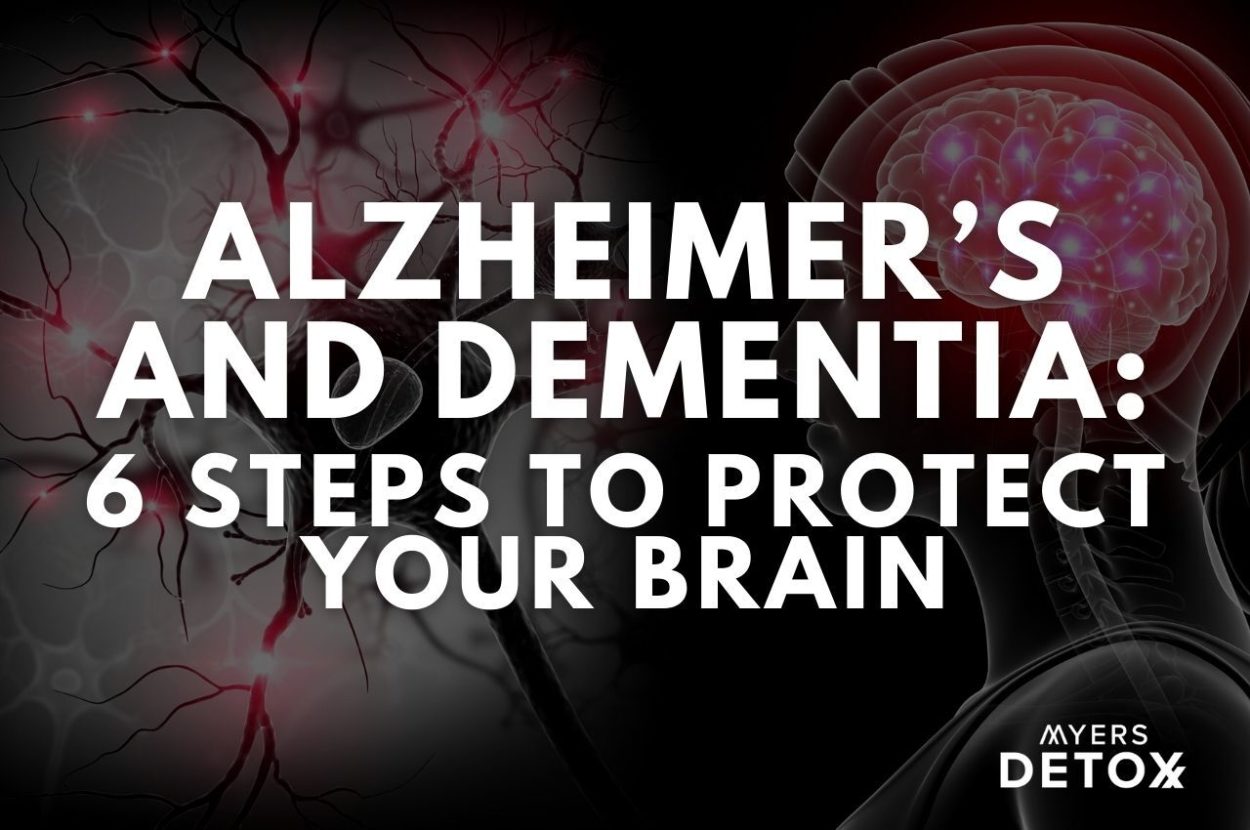Alzheimer’s is a progressive neurological disease that impairs memory, thinking, and behavior. As one of the fastest-growing conditions among the elderly, it’s estimated that 44 million people have Alzheimer’s worldwide, with 5.5 million in the United States alone[1].
Although there’s been a lot of energy put towards research into Alzheimer’s disease, the best that the medical community has come up with is a handful of pharmaceuticals that produce unpredictable results.
Instead of looking at Alzheimer’s as a single issue with which there should be a magical cure, we need to start looking at this neurological condition from a more holistic standpoint. What is at the root of Alzhemeir’s and what can we do to protect our brain function?
In this article, you’ll learn:
- What are the symptoms of Alzheimer’s disease?
- What causes this devastating condition?
- The role of Heavy Metals in Alzheimer’s
- How to support brain health and protect it from neurodegeneration without pharmaceuticals.
Symptoms of Alzheimer’s Disease
The symptoms of Alzheimer’s can vary depending on the person and the progression of the disease. With that being said, memory loss is the hallmark symptom.
In addition, other symptoms may arise, such as[2]:
- Difficulty concentrating
- Getting lost in familiar places
- Repeating statements or questions
- Challenges with thinking or reasoning
- Depression
- Apathy
- Social withdrawal
- Mood swings
- Distrust in others
- Irritability and aggressiveness
- Changes in sleeping habits
- Wandering
- Loss of inhibitions
- Delusions, such as believing something has been stolen
What Causes Alzheimer’s Disease?
Although billions of dollars have been raised in support of Alzheimer’s research, the exact cause of Alzheimer’s disease is still unknown.
What we do know, however, is that the neurological changes seen in this condition can be attributed to a handful of factors that damage and kill nerve cells; these include[3][1]:
- The deposition of amyloid plaques, which are protein fragments that build up in the spaces between your nerve cells.
- The buildup of tau proteins, which creates tangles and twisted fibers inside your nerve cells.
- Impaired glucose metabolism by the brain, resulting in a shortage of energy in brain cells.
- Toxicity in the brain from heavy metals like lead, mercury, cadmium, manganese, and aluminum.
Beyond these physical characteristics, emerging research is revealing some potential lifestyle and dietary influences that may play a powerful role in the prevention and perhaps even reversal of Alzheimer’s disease[4].
With this knowledge, we can start to look at Alzheimer’s as a condition that’s rooted in several imbalances instead of a single-cause disease. From this perspective, we can take the power to heal and protect our brains back into our own hands.
6 Tips To Support and Protect Your Brain
Below are six tips from research to help save your brain and protect your cognitive function.
#1 Try A Ketogenic Diet
The ketogenic diet involves strictly limiting carbohydrates so that your body adjusts to running on ketones as fuel instead of glucose. Under most conditions, your body burns glucose as its primary fuel source because it’s easy to come by, and even when carbohydrate intake is low, your body can create glucose from other dietary substrates.
On the ketogenic diet, however, you push your body into a new metabolic state called ketosis, where the primary source of fuel comes from fat.
Research shows that following a ketogenic diet may be beneficial for those suffering from Alzheimer’s for two reasons:
- Many people with Alzheimer’s have impaired glucose metabolism. – This means that the brain can’t use glucose for fuel optimally, and therefore energy to the brain is diminished. On the keto diet, impaired glucose metabolism is no longer a worry because you’re using ketones for fuel, not glucose. This provides an alternative energy substrate for your brain, which can help to keep things running smoothly[5].
- Ketones themselves are neuroprotective. – In addition to offering an alternative fuel source, ketones themselves also have neuroprotective properties. Research shows that when ketones enter the brain, they can reduce inflammation, enhance mitochondrial function, and calm mediators of cell death[3].
#2 Watch Out For Heavy Metals
Although most people are unaware, there is a shocking amount of toxic elements in our environment, and one of the most ubiquitous and dangerous of them all are heavy metals.
Once heavy metals enter your body, they are able to enter your cells and reach your brain easily. The heavy metals lead, cadmium, manganese, mercury, and aluminum, in particular, are neurotoxins that have been shown to cause impaired cognitive function and cognitive decline.
Lead
Lead, which can be found in everything from paint to lipstick, is a potent neurotoxin that impairs working memory. This heavy metal is associated with mood, fatigue, impaired learning, and lowered IQ. Lead toxicity is suspected to affect the production of neurotransmitters and the binding and transport of calcium, which are essential processes that impact brain function[12].
Cadmium
Cadmium is found widely in our environment, and exposure can occur through food, drink, inhalation, or direct exposure. Air pollution is one of the most common sources of cadmium, along with auto exhaust, batteries, and coal burning.
With that being said, many everyday products also contain trace amounts of cadmium, such as coffee, artist’s paints, and fertilizers — to name a few.
Cadmium toxicity affects many areas of the body, but this metal has an affinity for your brain. It can interfere with the function of acetylcholine and create hyperactivity in your nervous system. Cadmium may also directly damage your nerve cells[16].
Manganese
Manganese has a strong affinity for your brain and can cause neurodegeneration that mimics symptoms of Parkinson’s disease. This condition, called manganism, causes oxidative damage in the brain and can destroy mitochondria[17].
Manganese toxicity typically comes from inhalation of manganese particles in the air, as manganese skips the liver and travels directly to your brain [18]
Mercury
Mercury is one of the most well-known toxic metals in our environment. Historically, mercury was used widely in products like thermometers, paint, and even in the making of hats. Today, with the understanding of how dangerous this metal is, most of the mercury has been pulled out of man-made products, although many people still have mercury-containing amalgam fillings in their mouths.
Mercury can be deposited throughout your brain but has an affinity for your hippocampus and hypothalamus, two areas responsible for emotions, memory, and thyroid signaling. High levels of mercury are associated with fatigue, irritability, tremors, hearing loss, and hallucinations[13].
Aluminum
Aluminum targets the mitochondria in your cells, which are crucial for the production of energy. Through the generation of reactive oxygen species, aluminum creates oxidative stress, which damages your mitochondria, leaving your brain struggling to produce enough energy to carry out its regular functions.[14]
The neurotoxicity created by aluminum is associated with a range of neurological conditions, including Parkinson’s disease, Alzheimer’s, Autism, and Multiple Sclerosis[15].
Aluminum exposure can occur environmentally but is often due to contamination in your diet.
Understanding your heavy metal toxic load is crucial for the prevention of cognitive decline. While there are many tests out there, I always recommend a Hair Mineral Analysis, which can determine not only which heavy metals you have, but also which minerals you’re deficient in.
#3 Make Sure You’re Getting Enough Vitamin D
The best way to get vitamin D is through natural exposure to sunlight, which is why many people are deficient in vitamin D these days. This gives you 25 different types of vitamin D that you cannot get through supplementation.
Unlike our ancestors who would spend the majority of their time outside, today we live in houses and work in offices. Many of us don’t spend time walking to the store or gathering our food; instead, we drive to the grocery store, park, shop, and then get back into our car. In other words, our time spent outside has drastically diminished and continues to do so.
Unfortunately, one of the many risk factors that may come with low vitamin D is an increased risk for Alzheimer’s disease.
Research shows that vitamin D, through its impact on your immune system, may increase the clearance of amyloid plaques in your brain while also reducing their toxic impact on your nerve cells[7]].
#4 Protect Your Microbiome
The health of your gut bacteria can impact almost every system in your body, and neurological health is no exception. As researchers continue to uncover the direct relationship between the gut and the brain, the microbiome has become a topic of interest for Alzheimer’s patients.
So far, what we understand is that alteration in your gut microbiota can induce something called “leaky gut,” or intestinal permeability. This is when your gut barrier, which is meant to keep toxins out of your internal circulation, becomes weak or damaged.
When this happens, it can lead to systemic inflammation, which in turn may impair your blood-brain barrier (meant to protect your brain from toxic exposure). When your blood-brain barrier is no longer functioning properly it can lead to neuroinflammation, neurotoxicity, injury to your brain cells, and ultimately neurodegenerative diseases like Alzheimer’s[8].
You can take steps to protect your microbiome by choosing an anti-inflammatory diet, avoiding foods that you are sensitive to, and trying probiotics if you feel that you may already have an imbalance. Of course, if your gut microbiome is already off-balance, it’s best to work with a health professional that can help you with a dietary and supplement protocol.
#5 Manage Stress
You’d be hard-pressed to find any health condition or disease that isn’t negatively impacted by stress.
While it may feel like stress is purely emotional, the biochemicals released during the stress response can increase oxidation and inflammation in your body. Furthermore, the devastating effects can result in an endless cycle when it comes to neurological disease and the stress response.
This is because neurological disease impacts cognitive and motor function and can also disrupt the neural circuits that help your body mediate the stress response. Due to this disruption, what ends up happening is an elevated stress response due to neurological impairment and then an inability to combat that stress response, which leads to more stress, and the cycle continues[9].
Therefore, cultivating ways to manage your stress response can help to short-circuit the cycle and give your body and brain the assistance it needs to keep those biochemicals at bay.
Some wonderful stress-reduction activities include:
- Meditation
- Breathing exercise
- Yoga
- Physical exercise (running, dancing, weight lifting, sports, etc.)
- Journaling
#6 Care For Your Immune System
Two markers that are consistently high in Alzheimer’s patients are inflammation and immune activation[10].
Research shows that the sustained activation of the brain’s immune cells may exacerbate both amyloid and tau protein deposits[11].
Interestingly, studies have shown that beta-amyloid (of which the plaques are made up) has antiviral and antimicrobial properties. This suggests a possible link between the immune response against infections and the development of Alzheimer’s disease[10].
Exactly why these markers are elevated and why the immune response goes sideways is still yet to be uncovered. At this point, it’s a chicken-egg scenario; did the inflammation and immune markers cause the disease or did the disease create shifts in these markers?
Regardless of etiology, however, caring for your body’s immune response certainly can’t hurt.
Takeaway
The uncertainty around both the cause and cure for neurological disease leaves many people feeling helpless. If you’ve had a family member with Alzheimer’s or Dementia, you may even feel like cognitive decline is inescapable.
Instead of looking for the “magic pill,” we need to start looking at our own lifestyles, diets, and behaviors as a solution – as a preventative for dementia in its many forms. This holistic perspective allows you to fine-tune not just your cognitive health but the health of your body as a whole.
One of the most proactive steps you can take to arm yourself against neurological disease is to assess the levels of heavy metals in your body. Heavy metal toxicity is closely tied to cognitive dysfunction, and getting to this root cause early can be one of the most vital steps in protection and prevention.
*These statements have not been reviewed by the FDA. A Hair Tissue Mineral Analysis (HTMA) is not designed to treat, cure, or prevent any disease. It is not intended to replace any medication or healing modality prescribed by your medical doctor.










